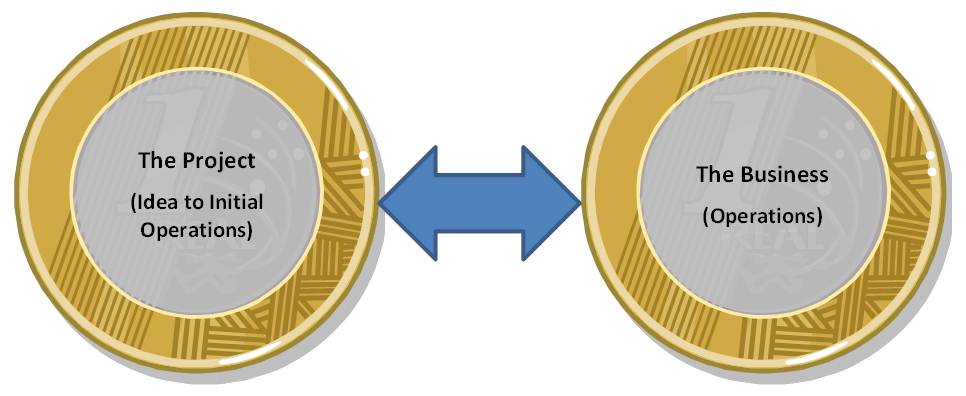This is our fourth article on entrepreneurship and a continuation of our last post!
In the last post, we stressed our view where we think that project management is the necessary link that is missing from the entrepreneurship world. We suggested a model, which is derived from the SUKAD Customizable and Adaptable Methodology for Managing Projects™ (CAM2P™), is a project life span model that divides the project life span into three distinct phases; which we explain here.
The Project Life Span for Launching a Business (Per SUKAD CAM2P™ Model)
 Business Concept
Business Concept
The business concept is a crucial phase of the project that spans a period from the idea for the venture until an initial decision to go ahead and encompass a feasibility study. The idea owner is likely to be the entrepreneur who has an idea for a business that could be a passion, an income opportunity, filling a need, fixing a problem, among other driver for the business.
This is the time for dreaming but one has to be careful that the dream is realistic and it is possible to achieve. It is highly risky for someone to launch a new venture without proper understanding of the challenges and opportunities; although one could argue in rare cases that spontaneous action could also result in good profit.
Therefore, the entrepreneur (small business owner to be) has to study the feasibility of his idea and for this we think that existing business planning techniques are very important to use at this stage. However, in addition to the focus on the financials, competition, market demand, operation and other factors, the entrepreneur needs to also think about project management including proper project management planning. Proper project management planning includes understanding of the stakeholders and their expectations and requirements, setting realistic time and cost targets, have a fair understanding of the project and venture risks (threats and opportunities), in addition to other factors.
Development of the Business Concept
 The earlier phase emphasizes the feasibility study and the requirement for business planning. With the business basics in place, project management will become more important and the entrepreneur becomes a project manager.
The earlier phase emphasizes the feasibility study and the requirement for business planning. With the business basics in place, project management will become more important and the entrepreneur becomes a project manager.
So what we do now?
The project manager/entrepreneur needs to think and act per two aspects, two sides of the same coin. On one side she needs to think about the project from idea to initial operations) but cannot ignore post project completion, which would be leading and sustaining the business (operations).

For the project aspect, the project manager needs to put in place all of the requirements in details for launching the business, including defining the success factors, timeline, required resources, licensing, legal, financial/funding requirements and alternatives, regulations, budget for the launch, timeline, communication with stakeholders, procurement strategy, in addition to risks identification, assessment, and management.
All of these activities focus on planning to taking us from the idea through project completion but primarily to produce a detailed plan that would give us the necessary information to make the final decision on whether we should continue with the venture or not. This detailed plan is used extensively in the next phase.
For the business aspects, the project manager needs to start planning for operation readiness; which means identifying all of the things needed once the business is operating; such as financial control, human resources, policies, operational processes, in addition to marketing and business development. If the venture is not for profit, it would still require most of these activities but may be with the addition of the needs for volunteers and volunteer management or the need for sponsors.
Project Delivery (Launching the Business)
With a plan for the project and a plan for operation readiness, it is time to start implementing the project leading to initial operations. In this phase we implement the activities that we identified in the detailed plan. For examples: in the plan we specified we need a permit, time to do the activities necessary to obtain the permit. In the plan we defined the need for a marketing plan, it is time to define the marketing plan and develop the necessary collateral, whether print or online.
Therefore, the primary purpose of Project Delivery is to perform all of the activities necessary to produce the required deliverables that would be critical for the successful launch of the new business and start initial operations.
Throughout this document we discussed initial operations and operations as two independent terms and this is intentional. We use initial operations to define the period of time that starts with opening our doors as a business or a not for profit organization. We call it initial operations because as we start to offer services we might recognize that forms need to be adjusted, some documents might be missing something, among other things that might not go as well as we planned. Therefore, initial operations will allow us to make the necessary refinements before we go into steady and normal operations. In some situations, we might eliminate initial operations and go straight into normal operations in other scenarios we might have a “soft start” as an initial operations period; which we might call also as a pilot period / trial period.
Which approach to take, it all depends on the nature of the business and if it allows a trial period / initial operations or not.

Very nice and informative info. Thanks for sharing this with us.
Thank you Mr. Saeed – I am glad you like it
this comment is By Prof.Suresh Kumar on LinkedIn
Sounds like A Phase–gate model,—-Phased scope development and investment decision is a fundamental concept of chemical engineering and engineering economics, particularly since the 1940s
– “Gates” or decision points are placed at places in the product development process that are most beneficial to making decisions regarding continuance of product development. These production areas between the gates are idea generation, establishment of feasibility, development of capability, testing and validation and product launch. At the conclusion of each of these areas of development of a new product, it is the responsibility of senior management to make a decision as to whether or not the product should continue to be developed. The passing of gate to gate can be accomplished either formally, with some sort of documentation, or informally, decided upon based on the preferences and culture of the organization.
In the chemical engineering world, and engineering and construction industry, phase-gate processes are often called front-end loading,and;finally
the continuation of the process is decided by (typically) a manager or a steering committee. The decision is based on the information available at the time, including the business case, risk analysis, and availability of necessary resources
Dear Dr. Kumar
Thank you for your valuable input. Yes, you are correct, this is built on a stage gate process, which is not applicable to chemical engineering or the process industry.
Appreciate your feedback and explanation.